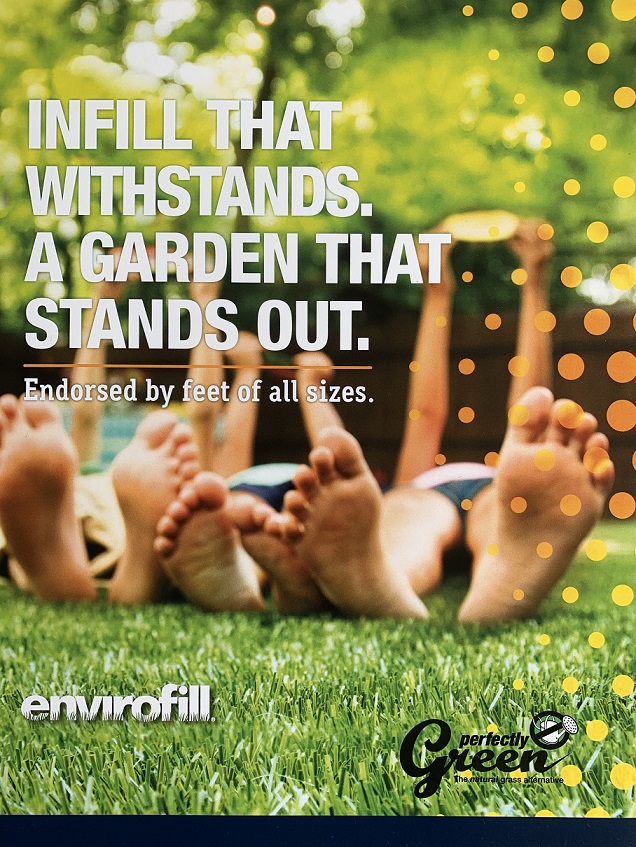Planning your artificial grass garden as a dog owner

Published: 17 May 2023
An artificial lawn can provide many advantages for those who can't manage or maintain their garden, through age or disability, or where natural turf is not an option for a variety of reasons. Synthetic turf lawns require a low level of maintenance but obviously don't require mowing, extra water or pesticides/fungicides. So, there are good reasons why a fake lawn may be preferential to a natural lawn.
Planning is always important to ensure that the right grass, base, installation, and maintenance is allowed for, and this planning is even more essential where a dog or dogs are likely to be using the garden. There are a number of issues to consider in terms of the initial installation, products selected and the subsequent care of the garden.
Important: If you are using a professional landscaper or artificial grass fitter please discuss the information in this feature with them.

The issue
When a dog uses the synthetic lawn as a toilet it must be regularly and thoroughly cleaned. Although we have plenty of rain in the UK, this is not enough to adequately clean the grass and remove the risk of unwanted smells arising from crystalised uric acid and the resultant smell of ammonia in warm weather. Think ahead and take simple actions to reduce this risk.
Planning and installation
Ensure that a suitable, solid and porous base is laid. The conventional base for synthetic turf is often made up of 50-100mm of Type 1 MOT with a 10-15mm top surface of sharp sand. If you have a dog you should avoid using sharp sand, in favour of granite dust or limestone grit, as sand particles are similar in shape and size to uric acid crystals and therefore likely to trap them below the artificial grass.
A weed membrane should form part of your base but avoid placing it directly on top of the base, beneath the grass. Instead, place the membrane under the main Type 1 MOT layer. If the membrane is directly below the grass it is just another layer of material to soak up and hold dog pee. Likewise you should avoid using a 10mm foam pad below artificial grass, if you have a dog, as this will also act as a urine sponge!
The grass
Some grasses are better for dog owners than others. While all are generally 'pet friendly', grasses with polyurethane (Pu) or polypropylene (Pp) mesh backing are advantageous because these backings will not absorb dog urine. Pu is a coating which is applied to the backing (in the same way as latex is applied) but the material is non-absorbent. Pp mesh does not require Pu or latex backing and dog urine is able to pass straight through to the base and away.
Blitz and
Mulsanne are Pu backed grasses while our new Evolve Range -
Huracan Evolve,
Diablo Evolve, and
Maximus Evolve - are all Pp mesh grasses. However, always remember that any artificial grass should be thoroughly cleaned where a dog is using it as a toilet as urine will still dry within the yarn, creating a pungent smell.
Additional products
Envirofill premium infill is a preventative product produced with an anti-microbial coating to help reduce the risk of dog smells, but it does not avoid the need to carry our regular cleaning of the grass. Envirofill should not be applied to an already smelly lawn as it will not reverse the existing problem. If you already have a smelly lawn you'll need to consider using a sub base and grass soaker - contact us for guidance.


Cleaning and maintenance
Always use an enzyme cleaner,
Wee Free for example, regularly and as required. Wee Free is a preventative
and remedial product, and should be applied to an artificial lawn from installation, particularly where the dog or dogs are taking a pee or poo! Don't be tempted to use a frangrance to mask smells as this is not a long term solution. It's vital to use an enzyme based product as this will address the problem thoroughly. Keep a suitable enzyme cleaner at your home to ensure you can apply it on a regular basis.
Summary
So, in summary, you should always:
- Be aware of the base build up, materials used and membrane positioning
- Select your grass carefully, some are better than others for dog owners
- Consider other preventative products such as infill to help maintain a healthy lawn
- Plan to carry out low level but regular cleaning and maintenance
It should be noted that some dogs produce more pungent urine than others, a factor that can be determined by diet. Not all dogs are the same!
Have a problem lawn right now?
If you don't undertake regular cleaning, throughout all 4 seasons, you risk ending up with a smelly lawn. You'll need to apply a sub base soaker to deal with it. The Wee Free sub base soaker will digest the uric acid crystals and other nasty things that are causing bacteria and smells within the turf. The cleaner is flushed through the grass, and gets to work cleaning the artificial grass base, where most of the dog wee has congealed.
For more information please contact us on 01825 729259 or email us 





Comments
There are currently no comments, be the first to comment.